








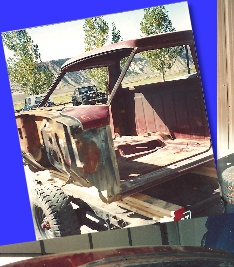
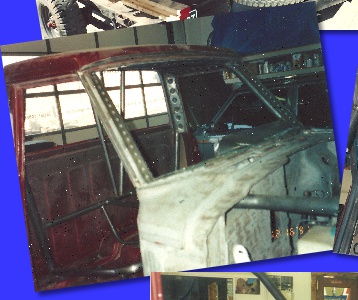

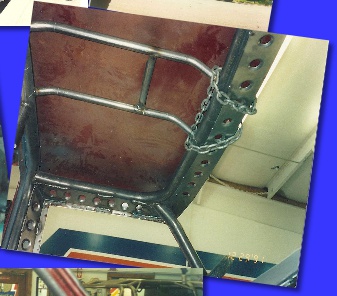

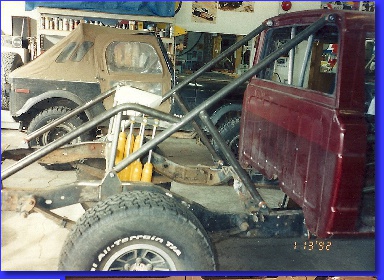
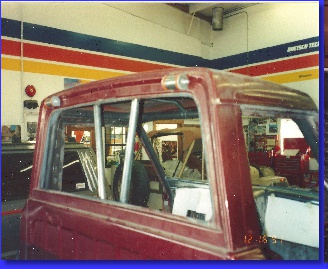
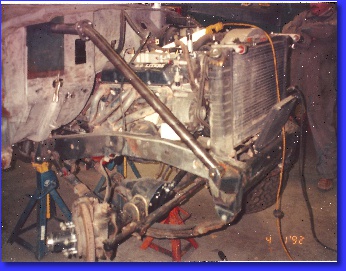
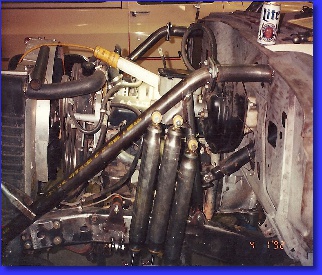
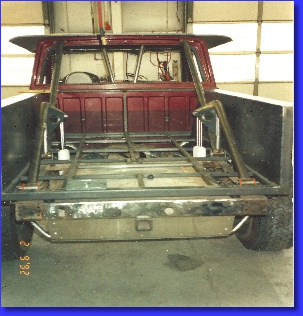

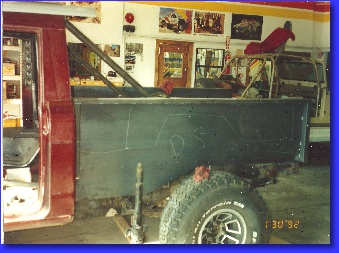
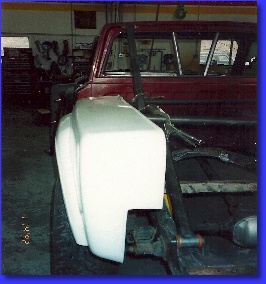
|
|
|
|
It all started with “Ugly Green Gator, the
Gladiator”. Yep, that’s what all my
“buddies” called my 1974 J-10, that was
obviously the factory green, faded and
rusted. It came with a 258 six cylinder,
T-18 4-speed manual, Dana 20 transfer
case, and some obnoxious clearance lights
on the roof (which we promptly removed).
I had bought it with anticipation of
someday building a really cool J-10 like
the pre-runners I’d seen hanging around
the off-road races, back in the early
1980’s. It went through several
changes, with the ugly green paint,
including suspension up-grades, bumper
changes and tires/wheels.
Finally, it was time to do some drive
train up-grades. I was in the process of
parting-out a 76 Jeep CJ-7 that had a
AMC 304 V-8, TH400 automatic
transmission and a Quadra-Track
transfer case, and transplanted them
into Gator’s chassis. After the bigger
engine, I had a friend paint it white and
stripe it. It lasted this way several
years.
Then I decided it needed even more
power, and we built a AMC 401 V-8,
with some up-grades like a mild cam,
390 AMX heads that except 6 to
1-ratio, roller rockers arms, better
oiling system, Thorley Tri-Y headers
and a carter 625 4-bbl carb. The new
401 ran good enough to surprise the
average Camaro owner!
After a few years of abuse, serving as a tow rig, pre-runner, shop truck, and daily driver, it
was time for a major body-off, frame-up rebuild. I acquired a 1980 cab (no brow), and
sandblasted the entire thing. Then did some major floor patching and built the internal cage.
Custom sheetmetal plates were built with hundreds of dimpled holes, for strength and the
cool look. They attached the DOM tubing to the cab interior. Each corner of the cage legs
extended through the floor and would act as the new cab mounts to the frame (through
polyurethane bushings). The entire cage was welded to the sheetmetal interior, forming one
very solid platform.
The entire chassis would also
benefit from the cage. Since the
cab was now attached directly to
the chassis, the rear kickers also
attached to the frame in three
places each, and at the upper
cab/rear window area. You can
see how this forms a “bridge”
over the frame and adds
tremendous strength to the
entire chassis. It also acts as a
great attachment point for
suspension components (shocks)
and other essentials.
On the firewall side, I extended
tubing through the sheetmetal (with
careful considerations for
components like the heater, A/C, and
fuse box). These extensions have
bolt/flanges to allow easy removal of
underhood tubing. The bolted on
tubes go directly to the frame and
also connect in three places each.
The cage structure now bridges the
chassis and is connected in 16 places
with poly-bushings.
I’ve always been a fan of the Jeep J-10
step side trucks, so I decided to
convert the style-side bed, to a
“glass-fender” step side. I found some
brand new fenders (long story), but
beds were no longer around (very
rare). So I built my own bed from
square tubing and sheetmetal.
I decided to raise it about 4” above the
stock step-side bed to make the truck look
taller, without adding height. This allowed
me to raise the step-side fenders up 4”
from stock. Plus this gave me more
clearance to fit the 35” tires under the
fenders.
Story and photos by Chris Overacker
Edited by Mark Smith

